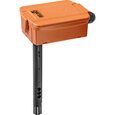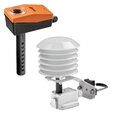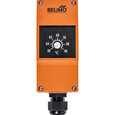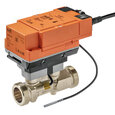Instruments For Measuring HVAC Processes
Figure 1: HVAC pressure gauge
HVAC measuring instruments are crucial in monitoring and maintaining air conditioning systems. Modern digital devices provide precise measurements and can record data for graphical representation, storage, and comprehensive computer analysis. This article discusses the various devices used in HVAC systems for various measurements.
Table of contents
- Pressure gauges
- Differential pressure switches and sensors
- Temperature sensors
- Temperature switches
- Energy meters
- Air quality sensors
- Humidity sensors
- Thermostats
- Flow sensors
View our online selection of HVAC instruments!
Pressure gauges
HVACpressure gauges (Figure 1) measure and display the pressure within various components, such as the evaporator, condenser, and refrigerant lines.
Types of pressure gauges
- High-pressure gauges: These are critical for evaluating the high-pressure side of refrigeration systems, with scales typically ranging from 0 to 34 bar (0 to 500 psi).
- Vacuum gauges:Vacuum gauges measure sub-atmospheric pressures.
- Compound gauges: Compound gauges measure positive pressure and vacuum, with pressure ranges from 0 to 16 bar (0 to 240 psi) and vacuum ranges up to 30 inches of mercury.
- Gauge manifolds: Gauge manifolds are designed to measure high and low pressures for comprehensive pressure assessment. These manifolds have color-coded hoses—blue for the low side and red for the high side. Manifolds are routinely used for maintenance tasks on air conditioner components.
Also, digital gauges provide clear digital readings, eliminating the interpretation errors that can occur with analog gauges, but are costly compared to their analog counterparts.
Figure 2: Pressure gauge manifold
Differential pressure switches and sensors
- Differential pressure switch: Acts like an on/off switch triggered by a specific difference in pressure exceeding a set point. For example, consider a clogged filter, which has an increased pressure drop across it. The switch detects this difference and triggers actions like fan speed adjustments or alarms.
- Differential pressure sensor: Continuously measures the pressure difference between two points and sends a proportional electrical signal (analog or digital). This helps monitor trends, optimize performance, and detect subtle changes in pressure indicative of potential issues.
HVAC differential pressure switches and sensors monitor air filters, control fan speeds, maintain proper duct flow, and operate variable air volume (VAV) systems.
Digital pressure switches and sensors
Digital pressure switches offer enhanced flexibility and reliability. They typically have:
- One or two output switch signals and an analog output from a single pressure port.
- Cost savings by reducing the number of measuring points and ports required.
- A package that may include accessories like a PVC tube, pitot tubes, and installation screws.
Figure 3: Differential pressure switch
Temperature sensors
Temperature sensors ensure an HVAC system's components do not cross their safe operating temperatures; they can sense parameters like temperature, absolute humidity, dew point, enthalpy, carbon dioxide, and VOX and convert them into a proportional output voltage. HVAC temperature sensors are installed in various locations, such as air ducts and refrigerant lines, or directly within spaces requiring temperature regulation.
These sensors measure the input parameter by:
- Making direct contact with surfaces within the HVAC system (contact sensors) or along the thermometer cable length
- Directly immersing into the liquid or gas in an HVAC. Immersion temperature sensors are often used with a thermowell to protect the sensor from pressure, flow, and corrosion.
Also, outdoor sensors can measure external environmental conditions such as temperature, humidity, and pressure. The data they collect aids in adjusting HVAC system operations to align with outdoor conditions, ensuring efficient energy usage and optimal indoor comfort.
Figure 4: HVAC duct immersion sensor
Temperature switches
Temperature switches (monitors) are components used in HVAC systems to control the system's function according to temperature changes. These devices operate by turning parts of the HVAC system on or off when the temperature hits a specific limit. This action is essential for keeping the temperature within a room or building at the preferred level.
Figure 5: HVAC temperature switch
Energy meters
A thermal energy meter measures energy (in kW) in commercial and residential buildings' closed heating or cooling circuits. It is essential for monitoring and managing the energy consumption and efficiency of HVAC systems. The meter supports the communication protocol the building management system uses, such as BACnet, Modbus, MP-Bus, or M-Bus. If remote access and data analysis are important, choose a meter with cloud connectivity or other remote data capabilities.
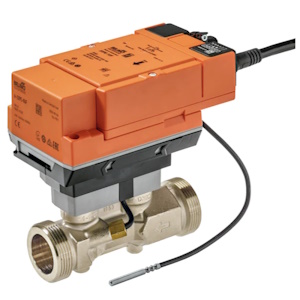
Figure 6: HVAC energy meter
Air quality sensors
Air quality sensors measure carbon dioxide (CO2) levels within air ducts. It is crucial for ensuring indoor air quality and comfort and managing ventilation systems in various settings such as commercial buildings, schools, and hospitals. Sensors with NDIR technology provide long-term stability and accuracy.
- The sensor measures CO2 concentration within a specified range, typically from 0 ppm to a maximum level.
- The output signal is provided in two common voltage ranges, 0-10 V and 0-5 V, to interface with control systems and monitoring equipment.
- Air quality sensors are installed in the ductwork of ventilation systems to continuously monitor the CO2 levels of the air being circulated throughout the building.
Figure 7: HVAC air quality sensor
Humidity sensors
Humidity sensors measure the amount of moisture in the air, maintaining optimal comfort levels for occupants and preventing issues like mold growth and equipment damage. The sensor adjusts airflow, heating, and cooling based on the measured humidity level.
The device detects the humidity level, and the output signal is a changeover contact from the leakage detector relay. Humidity sensors in an HVAC system are typically installed in the return air ducts, supply air ducts, or in the conditioned space to monitor and control humidity levels.
Features
- Adjustable height for the sensor to customize the response time based on the liquid level that needs to be detected.
- The relay contact can be connected to the controller and display systems or control a valve directly.
Thermostats
An HVAC thermostat measures temperature (input) and sends commands (output) to control heating or cooling equipment. It maintains a desired indoor temperature by:
- measuring current room temperature (usually via a built-in sensor).
- signaling the HVAC system to turn on/off heating or cooling based on the difference between the measured and desired temperature.
Thermostats are installed in residential, commercial, and industrial environments. Common locations include living spaces, offices, warehouses, and anywhere temperature regulation is necessary for comfort or process control.
Features
- Accurate temperature measurement for precise climate control.
- Compatibility with various control systems.
- Often easy to install and require minimal maintenance.
- Some models offer additional features like humidity measurement or network connectivity.
Figure 8: Room thermostat
Flow sensors
Flow sensors (flow meters) measure the fluid flow rate within an HVAC system. Flow sensors are installed in piping systems where precise flow measurement is required, like closed cold and hot water systems, including those with water-glycol mixtures.
Read our flow meter overview and installation articles for more information on HVAC flow meters' work, types, and installation practices.
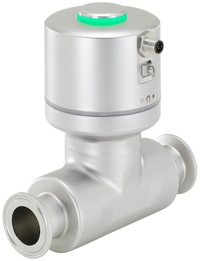
Figure 9: Burkert 8098 FLOWave L flow meter




